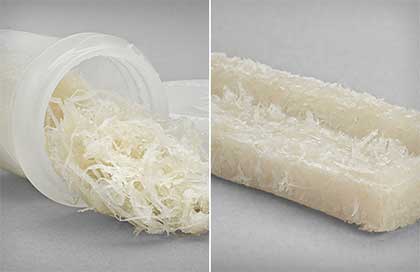AlloFuse® Select CM – clinically proven to activate and support bone formation and can be used in a variety of spinal, neurologic, and orthopedic procedures.
AlloSource, one of the nation’s largest providers of cartilage, bone, skin, soft-tissue, and cellular allografts to advance patient healing in surgical procedures and wound care, today announced the release of AlloFuse® Select CM, a premium addition to AlloSource’s AlloFuse portfolio.
AlloFuse Select CM combines osteoconductive, osteoinductive, and osteogenic properties to initiate and nurture bone growth, delivering the benefits of autograft bone without the potential drawbacks. The product is clinically proven to activate and support bone formation and can be used in a variety of spinal, neurologic, and orthopedic procedures. This cellular allograft matrix also has good handling characteristics, as it is moldable and compressible for insertion into interbody implants or placement around anatomical structures.
“AlloFuse Select CM underscores our commitment to offering surgeons the advanced solutions they need to support their patients’ healing,” said Kerr Holbrook, AlloSource Chief Commercial Officer. “Our passion for our donors and recipients is reflected in the continued expansion of the regenerative therapies we provide.”
The addition of AlloFuse Select CM enhances the AlloFuse portfolio of demineralized bone fiber, putty, paste, and gel allografts. This line expansion provides surgeons with a premium AlloSource cellular allograft to meet a variety of needs for patients.
About AlloSource
AlloSource is one of the largest nonprofit cellular and tissue networks in the country, offering more than 200 types of precise cartilage, cellular, bone, skin and soft-tissue allografts to advance patient healing. For more than 20 years, AlloSource’s products have bridged the proven science of allografts with the advanced technology of cells, offering life-saving and life-enhancing possibilities in spine, sports medicine, foot and ankle, orthopedic, reconstructive, trauma and wound care procedures. As the world’s largest processor of cellular bone allografts, fresh cartilage tissue for joint repair and skin allografts to help patients heal from severe burns, AlloSource delivers unparalleled expertise and service to its growing network of surgeons, partners, and the country’s most reputable organ procurement organizations. The company is accredited by the American Association of Tissue Banks and is headquartered in Centennial, CO. For more information, please visit allosource.org or our educational website, allograftpossibilities.org.
Media Contact
Megan Duggan | AlloSource
720. 382. 2766 | [email protected]
FAQ
What is an allograft?
An allograft is a tissue or tissues transplanted from one person to another. Allografts are used in a variety of medical treatments such as knee replacement, bone grafts, spinal fusions, eye surgery and skin grafts for the severely burned.
Where does the tissue come from?
Allografts come from voluntarily donated human tissue and donors can be living or deceased. A deceased donor has documented his or her choice to be a donor through registries like Donate Life America or the family has made the decision following death. Organ and tissue donation represents a gift from the donor and the donor family.
Is allograft transplantation safe?
The possibility of disease and/or infection transmission from allograft transplantation is extremely low, estimated to be less than one in 1.6 million. AlloSource makes every effort to eliminate this risk and has not had a substantiated incidence of disease transmission.
What type of safety screening occurs?
Prior to processing, all potential tissue donors undergo a comprehensive screening that includes a physical assessment, medical history and social risk review. Tissue is then recovered and tests are performed on blood and tissue samples to screen for disease and bacterial infection. Testing required by the FDA and AATB includes screens for HIV, Hepatitis B and C, and syphilis.
How is this industry regulated?
There are presently three regulatory organizations that oversee tissue banking: the Food and Drug Administration (FDA), the American Association of Tissue Banks (AATB) and the Clinical Laboratory Improvement Amendments (CLIA).
Will the recipients discover the identity of the donor?
Donation usually remains anonymous. In some cases recipients and donor families may wish to contact each other. Efforts to unite a donor family with a recipient are typically coordinated by the Organ Procurement Organization (OPO). AlloSource sponsors a program where donor families and recipients can exchange letters to share stories about their experiences with donation. The Pathways program’s vision is: The family of every organ and tissue donor will receive acknowledgement from someone who has benefited from their loved one’s gift. If you are interested in participating in the Pathways Program or to learn more, visit www.1000thanks.com.
What is the difference between an autograft and an allograft?
An autograft is tissue removed from one part of a person’s body and transplanted into another part of the same person’s body. An allograft is tissue recovered from a tissue donor and transplanted into another person (the recipient).
Source: AlloSource







